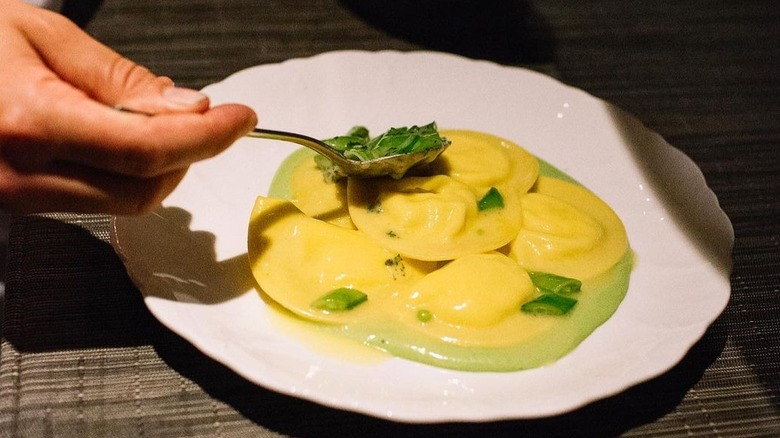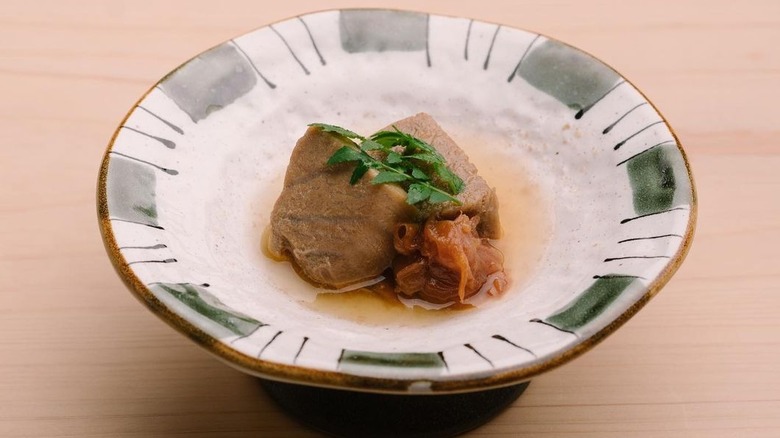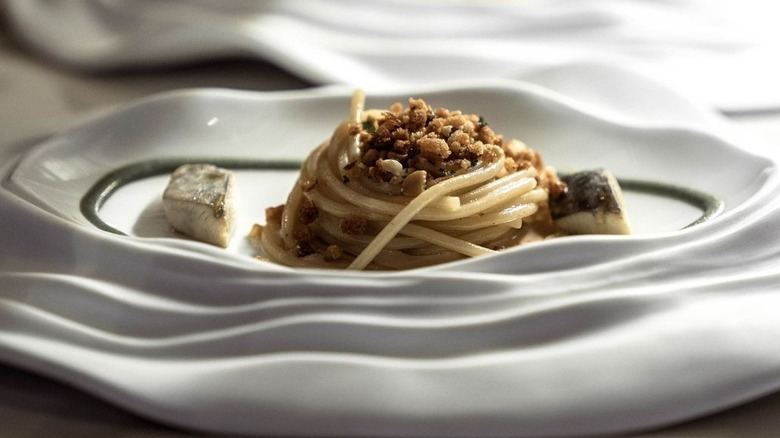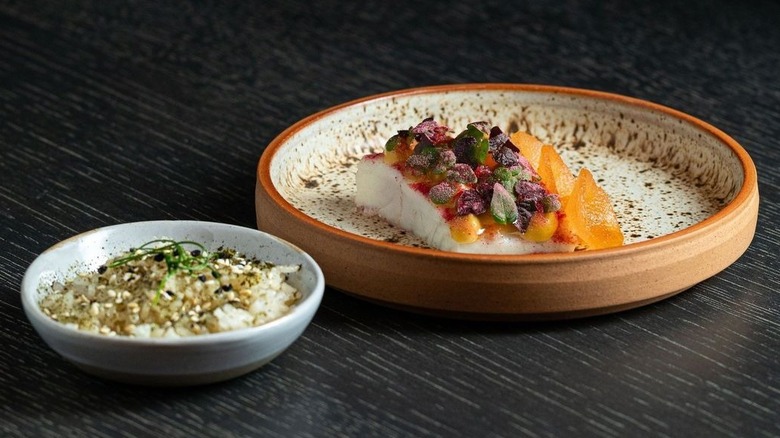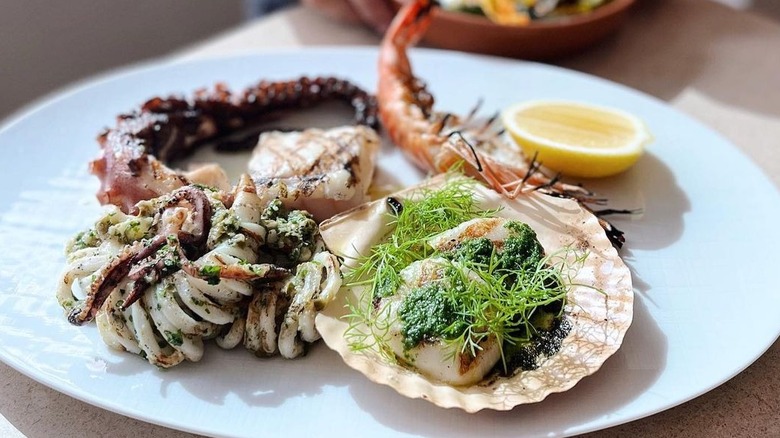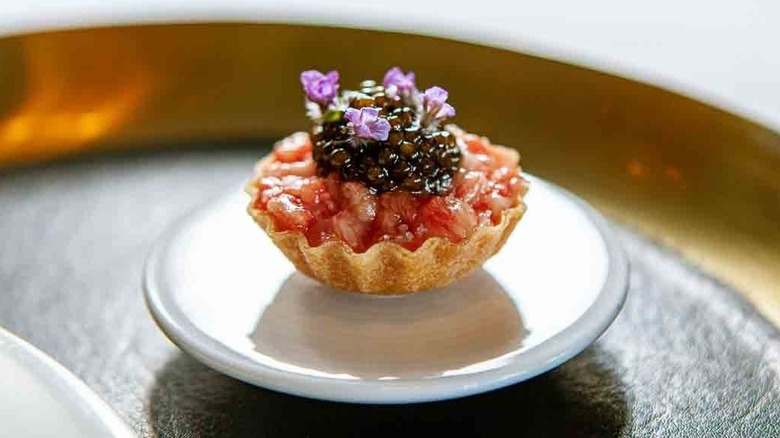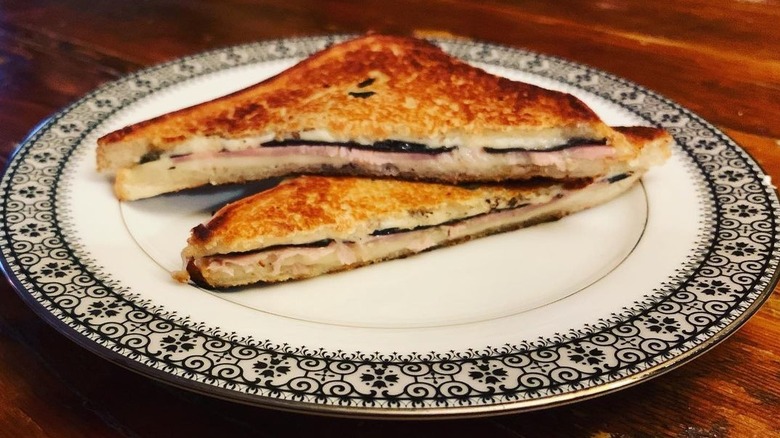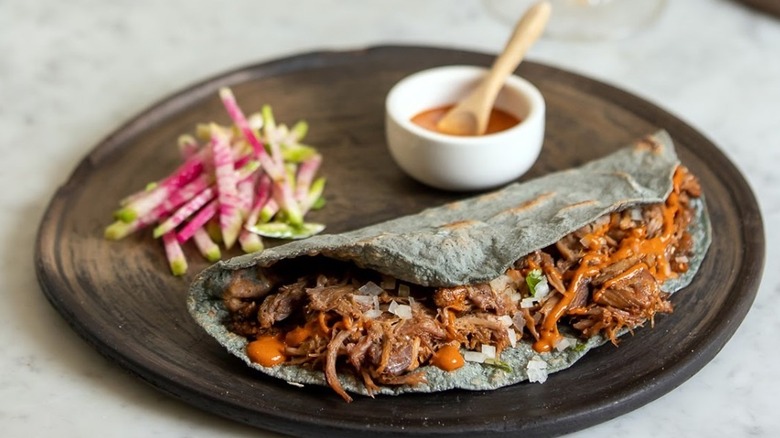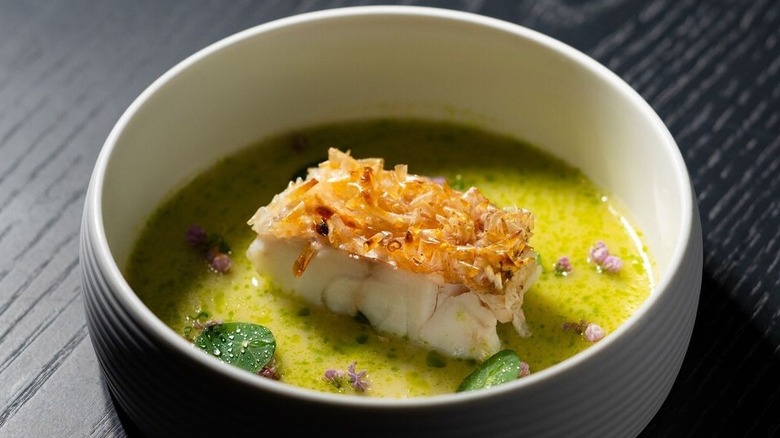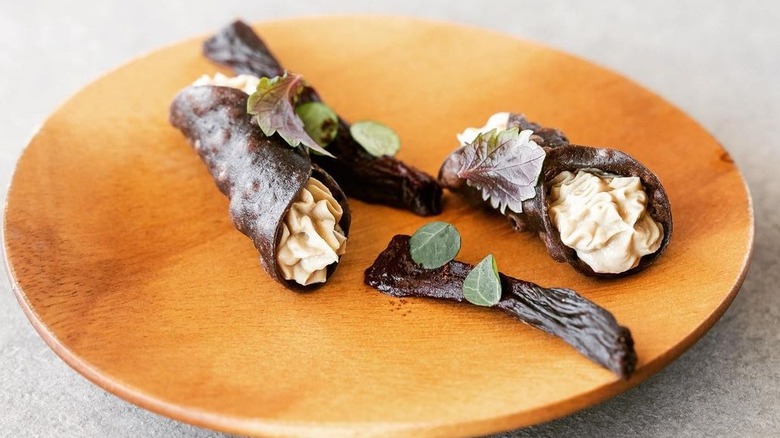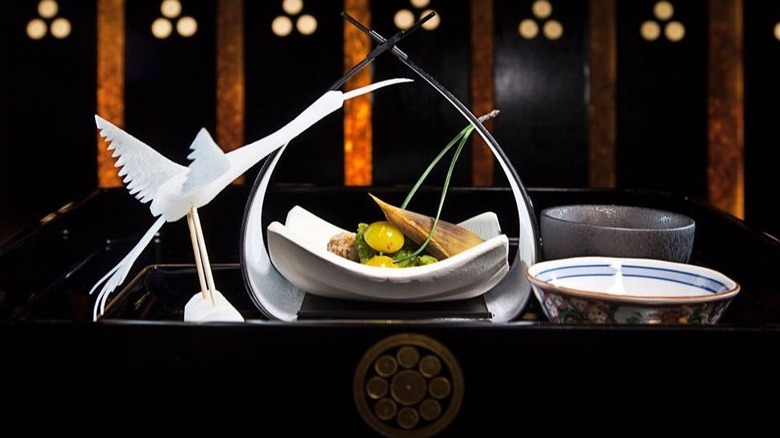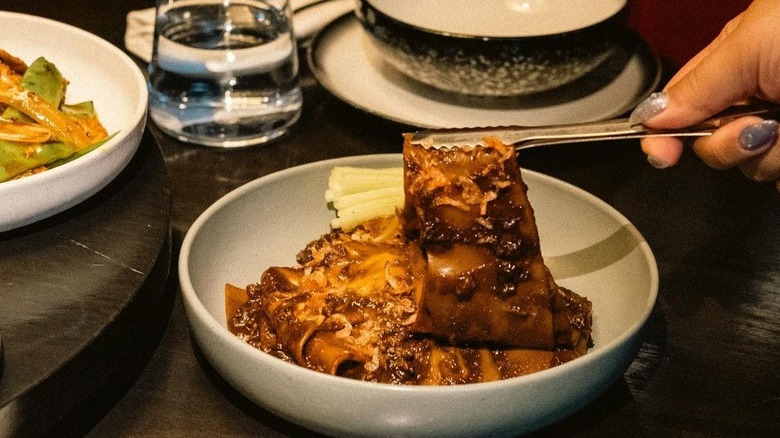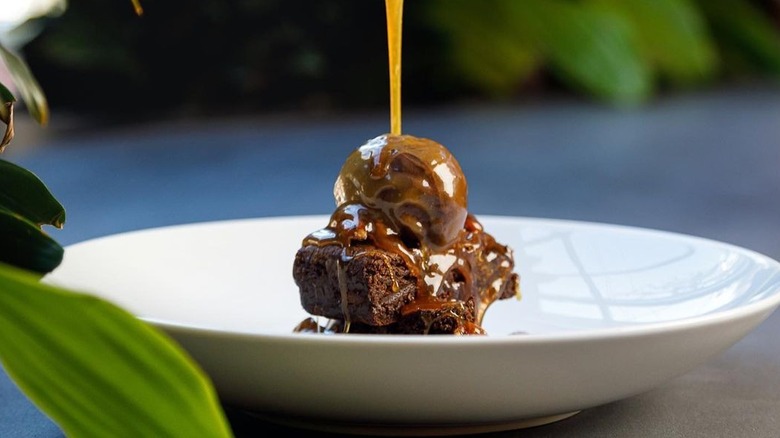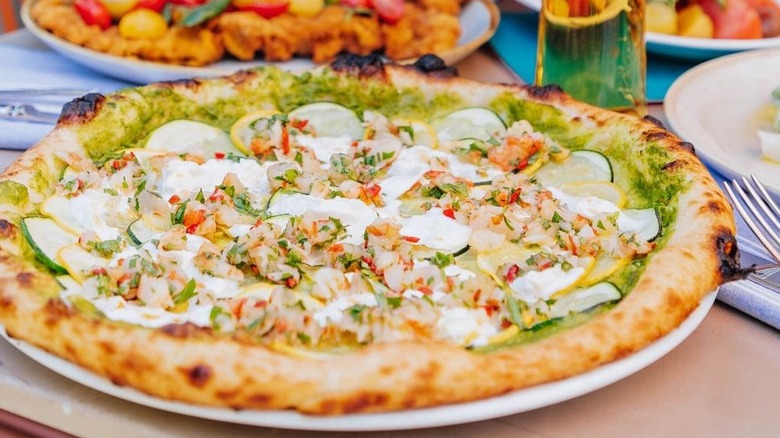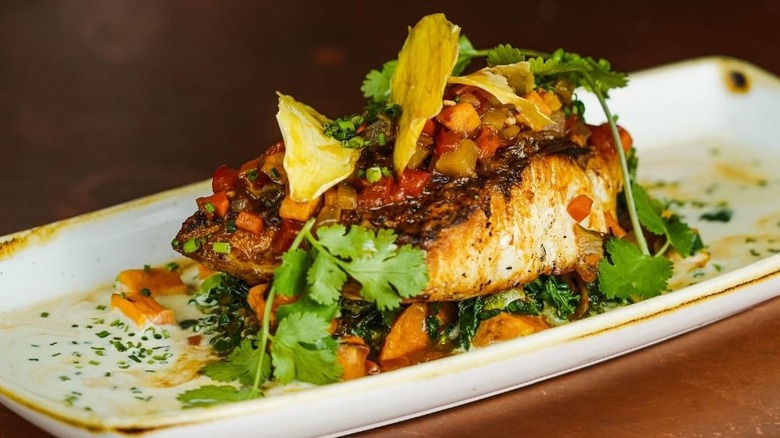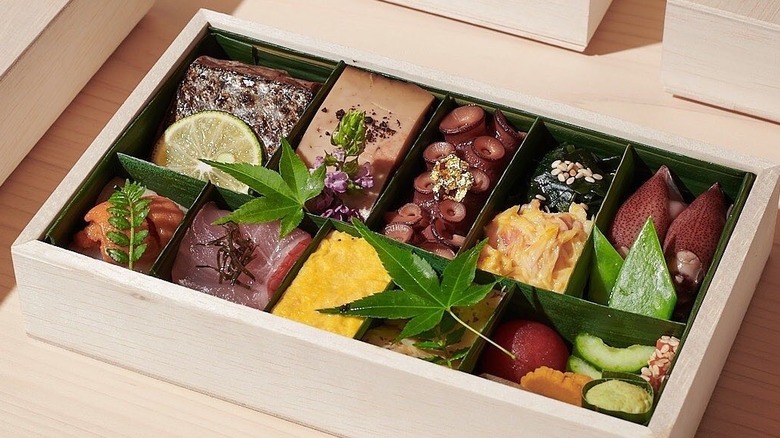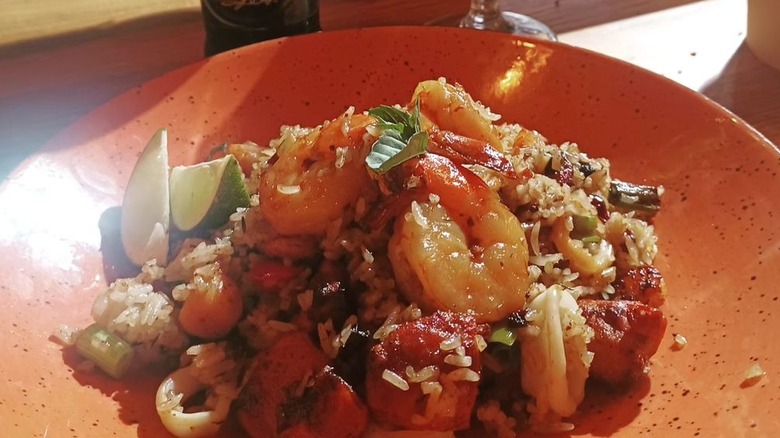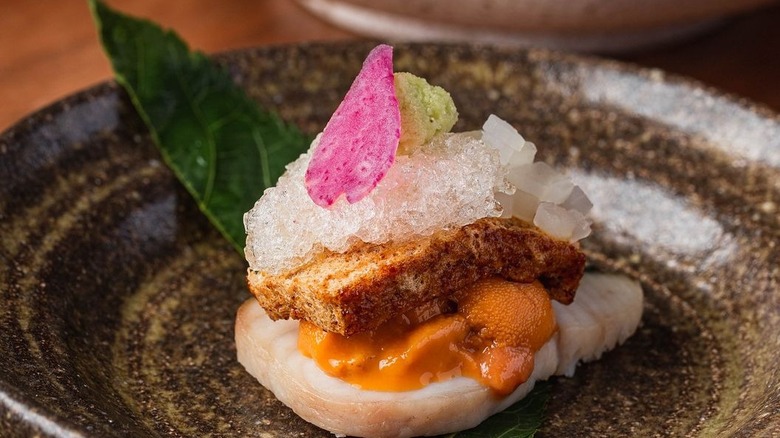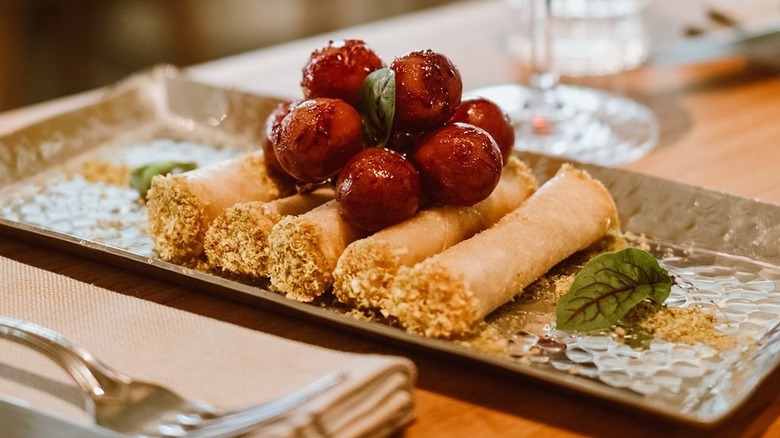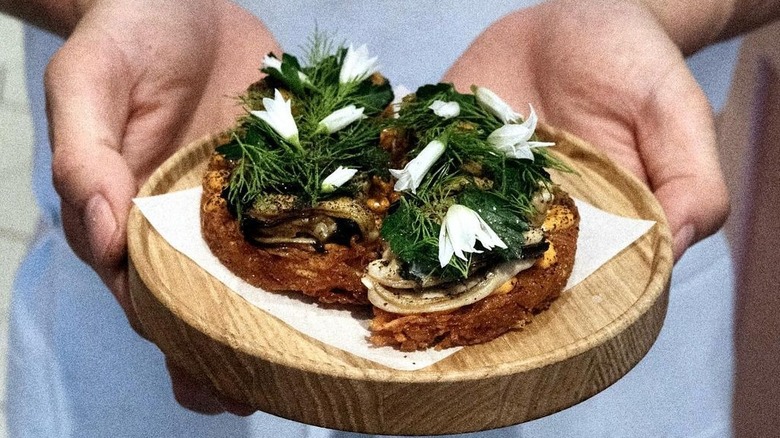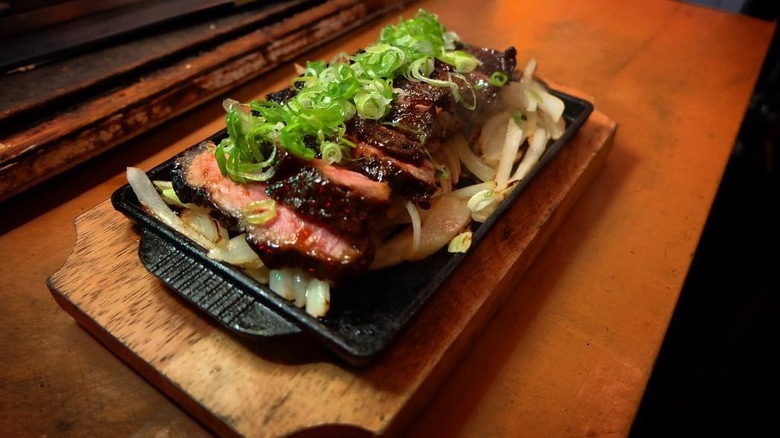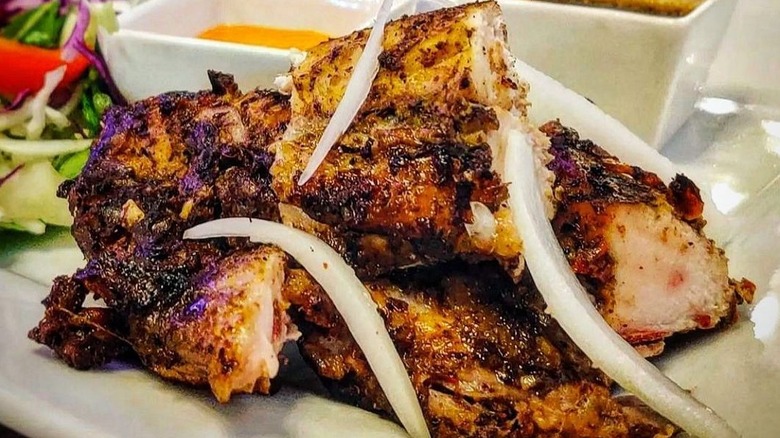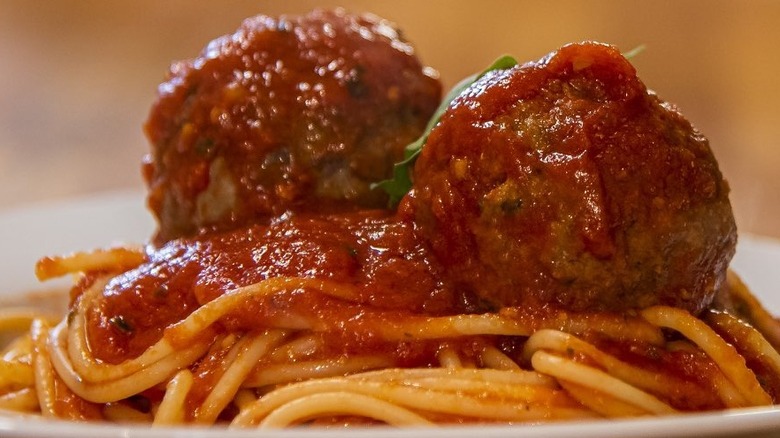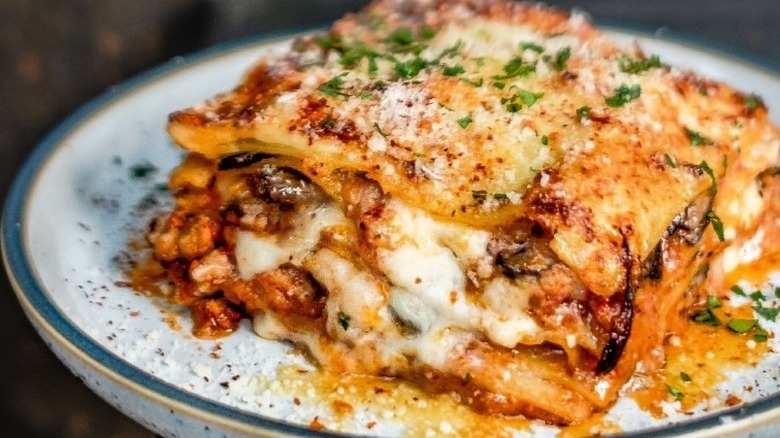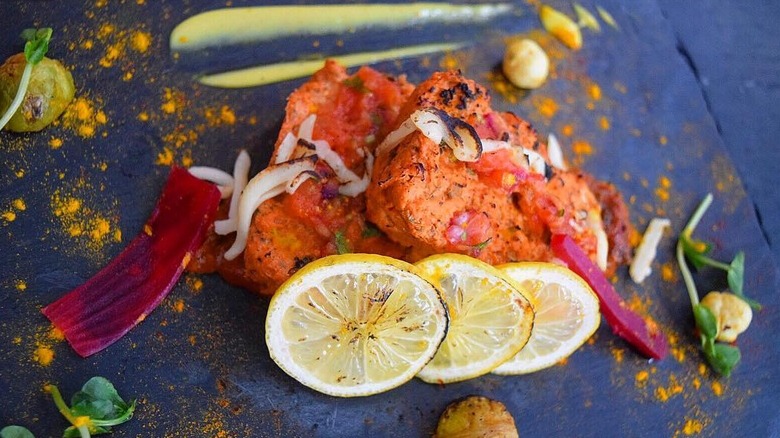The 25 Best Restaurants In Toronto
Toronto is a diner's paradise for those in the know, and its motto, "Diversity our strength," has much to do with that. According to a 2017 study by The BBC, Toronto is officially the most diverse city in the world. With a populace representing 200 different ethnic groups with over 140 languages, it should come as no surprise that Toronto's restaurant culture would be reflected in that.
Within that myriad profile, you'll find Michelin-starred restaurants you should visit at least once, neighborhood haunts that are local faves, and hole-in-the-wall powerhouses of culinary delight that even locals aren't necessarily up on. In Toronto, restaurants that are marvels of elevated design present artistically plated morsels just right around the corner from ramshackle comfort food holdouts of more earthbound price points and DIY design cred. Ultimately, we're here for the food, and Toronto has that to offer in spades. Here are our picks for the 25 best restaurants in Toronto right now.
Alobar Yorkville
Situated in Yorkville, Toronto's answer to Greenwich Village, Alobar Yorkville has been a consistent jewel in Toronto's culinary crown since its launch in 2018. Hidden in a side path between Yorkville's two main strips, Alobar is a beautiful cocktail bar slash restaurant that offers diners the best of both worlds.
The wine and beverage program is directed by Michelin award-winning sommelier Christopher Sealy, and the restaurant itself boasts its own Michelin-star for an all-star menu of carefully curated dishes. Prices range from $24 for two pieces of chilled lobster with lime aioli, avocado, and gem lettuce, to a 24-ounce, $150 bone-in USDA ribeye steak, lavishly presented with cremini mushroom and beef jus.
Shoushin
Shoushin is a high-end Japanese sushi restaurant that's all about wild-caught fish imported from Japan, served at a chef's table with seating for a maximum of 14 diners. A $330 Tasting menu offers six sushi incorporating everything from grilled cutlass fish with daikon radish to a surprise dessert.
For an extra $130, add a sake pairing that will demonstrate the difference between sake and rice wine in a hurry while also proving that sake is not just for sushi anymore. You won't need any tips for ordering omakase with a $480 chef's table-style curation of the best seafood of the season.
Don Alfonso 1890
This Michelin-starred establishment is, according to the likes of Top 50 Italy, the second-best Italian restaurant in the world in 2023. What that means is you won't find anything as pedestrian as Margherita pizza — an Italian menu staple that most chefs view as played out — anywhere near your plate or the menu.
A $220 tasting menu goes beyond expectations and includes seared Quebec muscovy duck breast with a puree of celeriac, pomegranate sauce, and spinach. The presentation is reminiscent of abstract art. An a la carte menu for $140 offers risotto with flare. Iranian saffron broth, 36-month-old Parmigiano Reggiano cheese, and veal shank take the humble rice dish in a delectable and original direction.
Enigma
Enigma is a modern European fine dining restaurant that is all about its carefully executed 2.5-hour tasting menu. This means there are no difficult decisions or fine dining menu rules to follow once you've left your food fate in the capable hands of Executive Chef Quinton Bennet.
Reservations must be made in advance and require a non-refundable deposit to secure.The six-course gourmet menu is rotating and secretive, and at $185 per person, isn't cheap. Neither is the eight-course seasonal tasting menu at $230 or ten courses offered as a $480 chef's table experience. But if there's anything a Michelin star and our taste buds tell us, it's that the expense is worth it, and at least you won't find yourself having to wait for a table at a fancy restaurant.
Osteria Giulia
Another Italian standout on the list of best restaurants in Toronto is Osteria Giulia, an eatery focused on the seaside cuisine of Liguria, Italy, a region also famous for introducing the world to pesto and focaccia baked with stracchino cheese. As such, you can look forward to the aforementioned focaccia as a house specialty and a menu heavy on the ocean's bounty.
In particular, two dishes deliver the Ligurian seaside in pasta or risotto form: there's wild Dungeness crab served with Carnaroli rice, white asparagus, and sherry or braided pasta with bay scallops and squid in garlicky anchovy and chili finish. The latter dish is part of a pre-fixe menu that feeds eight to 10. Meat is no laggard either, with a grilled rack of lamb or 28-ounce striploin steak for two.
Alo
Alo is the sister restaurant to Alo Bar, or vice versa if you base that on what came first. Alo restaurant is also blessed with a Michelin Star for high-quality cooking. Just as important, it was named the best restaurant in Toronto for 2023, according to an esteemed panel of leading Canadian food industry experts.
With such high praise comes a $225 per guest tasting menu and a two-month waiting list for reservations on average. Another $135 gets you a wine pairing by a Michelin-endorsed sommelier. If you want to bypass the line, you can book a private dining room for a six-course tasting that includes cocktails, sparkling wine, and canapes. According to Alo's Tock listing, that private experience comes with a $375 commitment predicated on a $200 deposit per person.
Edulis
Edulis borrows its name from Boletus edulis, a particular kind of porcini mushroom.It also translates from Latin to mean "edible." Located in Toronto's fashion district, Edulis' married pair of chefs and owners, Tobey Nemeth and Michael Caballo, have successfully cultivated a fine dining ethic with a casual neighborhood hominess.
Edulis stays true to an ethos of seasonal availability. A weekly rotating menu makes it difficult to nail down the multi-course set, but a Michelin star offers a sense that good things should be expected. On famed food critic Ruth Reichl's blog, the acclaimed writer hints at a fabulous dinner, describing "the most extraordinary wild Nunavut Arctic char" and goes on further to proclaim, "We ate in a kind of dream; here a bit of sausage, there the softest slice of lobster mushroom."
Quetzal
Although owned by Chef Grant van Gameran, Head Chef Steven Molnar has helped Quetzal be recognized as a Michelin star earner for its smoky Mexican-themed wood and charcoal-fired delights. A 10-meter-long grill brings the flame and aids in the preparation of an Oaxacan-inspired menu fusing both imported Mexican and locally sourced food.
Traditional Mexican dishes don't at all suffer from experimentation. Try the Ossetra sturgeon caviar to start, served with crema and chives with tortilla or bone marrow and wild Argentinian shrimp, an imaginative play on surf and turf dressed with pasilla and locally sourced wildflower honey acting as sweet glaze alongside more tortillas. A curated tasting menu comes in at $110 with a $90 beverage pairing.
Aburi Hana
Chef Ryusuke Nakagawa's Aburi Hana is a restaurant serving modern Kaiseki-style cuisine. When eating kaiseki, expect to experience a Japanese culinary tradition laser-focused on freshness, seasonality, and vibrance. Equally as capable in the beverage department as it is in food, Aburi Hana has earned both a Michelin star and recognition by the Star Wine List, an international collection of top wine bars and restaurants.
Aburi translated from Japanese, means flame-seared, and the menu boasts traditional and contemporary techniques involving that most essential culinary element, fire. A $380 per guest, the kyō-kaiseki experience is a once-in-a-lifetime opportunity. Although the eye-watering cost doesn't include beverages, since you're already splurging on food, it would be foolish not to continue the splurge on alcohol in a restaurant lauded for its alcohol selections.
Frilu
Friluftsliv is a Norwegian word that means "one with nature" and is also the root of Frilu's name. A 12 to 14-course seasonal tasting menu never lets you forget that link to nature, taking inspiration from Asian flavors and cooking practices. Sommelier Yuya Shimomura goes all out on an alcohol or alcohol-free food pairing with herbaceous, spicy, or tangy ingredients as her muse.
Chefs John-Vincent Troiano and So Sakata bring Japanese-influenced dining to the uptown suburbs of the Greater Toronto area guided by the bounty of four seasons. Frilu's partnership with Willowolf Farm, a farm located north of Toronto, provides all the necessary ingredients for an authentic farm-to-table dining experience. The Michelin-star restaurant offers a three to four-hour experience with pairings for $260 per person.
Kaiseki Yu-zen Hashimoto
Japanese cuisine reigns supreme in Toronto, and Kaiseki Yu-zen Hashimoto adds another amazing restaurant to our list. Interestingly, at Kaiseki Yu-zen Hashimoto, wearing strong perfumes and colognes is a big no-no. This is out of respect for the other diners around you and the enjoyment of their meal. Located in the Japanese Cultural Centre, the restaurant aims to represent seasonality on a plate based on Japan's seasons rather than the West's and is so focused on culture and etiquette that dinners conclude with a traditional tea ceremony.
Chef Masaki Hashimoto and son Chef Kei Hashimoto's $350 per person eight-course menu doesn't include sushi, which flies in the face of most people's expectations of a Japanese restaurant, preferring cooked dishes except for a dessert and a single sashimi dish.
Mimi Chinese
The biggest mistake you're making when eating at a Chinese restaurant is likely ordering individual dishes that act as culturally void, Westernized versions of Chinese food. Instead, Mimi's Chinese, which translates into "beautiful, beautiful Chinese," promotes the cultural practice of sharing dishes with authentic platters inspired by different regions within China in a dimly lit, upscale setting. Expect regionally listed menu items like stir-fried pork jowl with doubanjiang and Sichuan snow peas or Hunan chili sea bass with house-fermented chili, Fujian wine, and flowering chives from Hunan province.
Vela
Half a block north of the often frenetic energy of King West's entertainment district sits Vela, a restaurant helmed by alumni of the aforementioned Alo, as well as Bar Raval. The vibe at Vela is "majestic boutique hotel meets a sexy jazz lounge for beautiful people." A covered garden patio leads to a massive yet curvaceous interior with strategically placed lighting that makes carefully plated food and perfectly coiffed diners pop.
A starter at Vela may look like burrata with pistachio pesto, figs, and locally grown cherries adorned with a burnt honey vinaigrette. It could also be a fried oyster from the waters of Prince Edward Island served with caviar and peppercorn ranch. A raw bar includes a seafood platter with Hokkaido scallops, tuna crudo, tiger shrimp, snow crab, and a half lobster. Imaginative plates of pasta and delicious mains round out the menu.
Oretta King West
A block south of Vela, located on the entertainment district strip, is Southern Italian-inspired Oretta. The owner, Salvatore Mele, wanted a big 250-seater restaurant with great lighting to compliment the food. The English translation of Oretta ("an hour") references the minimum amount of time he hoped anyone would want to stay in the establishment.
The full range of antipasti, salads, wood-fired pizzas, meat, and fish complimenting the dinner menu makes the thought of leaving early an impossibility. A brunch menu includes the same pizza and pasta items alongside Italian pastries, with porchetta or prosciutto replacing bacon along a bevy of egg dishes. A Monday to Friday aperitivo hour offers a reduced price on food and drinks.
Chubby's King West
Chubby's is a Jamaican restaurant helmed by Chef de Cuisine Dadrian Coke, formerly of Sandals Resort Negril. The two-story,100-seater restaurant's colorful interior is complemented by a smaller patio out front for sunlit people-watching with a focus on authentic, classic Caribbean recipes.
From starters: Likkle Bites, like oxtail red pea soup or spicy pepper shrimp in garlic butter with house-made hard dough bread. The Big It Up section has mains à la woodfire grilled jerk chicken, curry goat, and pan-seared snapper fillet; Chubby's has your island experience north of the Caribbean sea covered. A classic Jamaican brunch includes a plate of ackee and saltfish with fried dumplings, plantain, sautéed greens, and boiled green banana.
Sushi Masaki Saito
Back in 2019, Chef Masaki Saito became the first Michelin-star chef to permanently establish a restaurant in Toronto after departing Sushi Ginza Onodera in New York — also one of the most popular sushi restaurants in Los Angeles. In doing so, Saito brought umami-packed, Edomae-style cured and marinated seafood (and other Japanese-imported ingredients)with him.
Sushi Ginza Onodera quickly demonstrates the difference between sushi and sashimi with fresh fish wrapped in authentically prepared rice, deftly making a case for why sushi tastes better at a restaurant than at home. A $680 per person omakase dinner is prepared with gracefulness and skill that makes this a Michelin-starred restaurant you should visit at least once (if you can handle the price point).
Afrobeat Kitchen
Afrobeat Kitchen's Victor Ugeweke went from a popular pop-up kitchen to owning a restaurant in Toronto's Parkdale neighborhood. Since then, his Nigerian-influenced fare has both converted newbies and received nods of approval from the Nigerian community with modern takes on cultural cuisine.
Ugeweke makes a case for why jollof rice should be considered among the best rice dishes around the world. While not traditional, his use of lemongrass and star anise in a smoky, slow-cooked sofrito reduction with smoked crayfish is a fresh take on a classic dish. The stars of the miso mafe and peanut stew is a heavenly union of young jackfruit, eggplant, and chickpeas, served on a bed of coconut rice.
Yukashi Japanese Cuisine
Chef Daisuke Izutsu's Yukashi Japanese Cuisine is an intimate 20-seater restaurant with an omakase or "chef's choice" style menuless service that may include tuna belly, hay-smoked fish or deconstructed woodland veggies under zen-inducing mood lighting. It offers nine courses with a limited amount of sake pairings for $250 per person, which is interesting considering sake isn't often paired with sushi in Japan. Still, Chef Daisuke has been a key fixture of Toronto's Japanese cuisine for decades, so best to trust the professionals.
Amal
Lebanese transplant and Executive Chef Rony Ghaleb brings fine dining swagger to modern Lebanese cuisine. Nestled above Yorkville on the second floor of an upscale retail building, Amal offers diners lovely views both inside and outside of the restaurant.
The halal-certified menu includes all the traditional dips like garlic labneh and baba ghanoush, seared halloumi, skewered proteins and vegetables with house-made spice combinations, and interesting entrees like branzino filet. Meanwhile, the kefta patty, topped with tomato, preserved lemon, aioli, and kale-cabbage slaw, elevates a burger miles beyond any you're likely to taste, with a premium mix of Lebanese spices.
156 Cumberland
Head Chef MJ Jeong and Front of House Manager Jenffier Yeo are a husband and wife team getting rave reviews for their contemporary reimagining of traditional Korean recipes made at 156 Cumberland, which also happens to be the restaurant's address. Spanish mackerel gets with a gochujang glaze, while ssam platters featuring different cuts of beef are served with varying types of kimchi and seaweed rice. Dessert marries Italian tiramisu with Korea's popular flavored drink, banana milk. A roasted brown ice cream with the sweet addition of yuja and sesame caramel delicately balances earthy and sweet.
Hanmoto
What the raucous late-night spot Hanmoto lacks in space, it makes up for in food offerings. Inspired by the rowdy izakaya of Japan, the restaurant serves Japanese-American style small plates to a 90's hip-hop beat. Japan's casual, communal drinking and dining style suits the crowd in this close-quartered dining room hung with neon signage.
House faves like fried Dyno Wings are served in classic Chinese takeout boxes and drizzled in spicy-sweet soy glaze chased by kewpie mayo, pickled chilies & nori. Hanmoto's take on McChicken employs tartar sauce with iceberg lettuce and nanban sauce, andit should go without saying, but Hanmoto's version is way craftier.
The Diner's Corner
The Diner's Corner is a casual, mid-size restaurant that takes the best food in the Caribbean and skillfully serves it up to loyal diners. If you recognize the Caribbean as a food destination more people need to be talking about, then you get a sense of how necessary Diner's Corner is to Toronto's food scene.
The West Indian bistro goes beyond the limited seating arrangements of most takeout and delivery restaurants of its ilk, with a long bar and ample indoor-outdoor seating. Elegantly plated oxtail with rice and peas, curry chicken, and escovitch fish make this worth the trip to Toronto's Yonge Street, which isn't the Caribbean but is as close as you can get foodwise.
Morso Me
From the framed picture of her family in Italy on the walls to the Italian nonna-style traditional foods made with love, chef and owner Maria Strazzanti's neighborhood standout doesn't need fancy fusion or an army of designers to make it notable. Perfectly executed classics like the Parm sandwich, a plethora of mouth-watering pasta, and housemade bread and canolis have office workers and emergency responders lining up outside the tiny takeout and delivery spot. If you can snag one of two tables inside or curbside, consider yourself lucky.
Gusto 101
Gusto 101 is a two-story converted auto garage made into a happening establishment where the house wine goes for a dollar per ounce. Owner Janet Zuccarini also happens to own Chubby's across the street, and she brings the same care to this the restaurant.
Gusto's capable line cooks work out in the open, efficiently spinning out an encyclopedic-sized Italian menu. It includes standouts like the Cavolo Nero, a chopped kale salad adorned with Pecorino cheese and currants, as well as a creamy, mushroom-heavy mafalde ai funghi pasta, and any pizza that comes out of the Gusto's stone oven.
Aanch
South Asian Fine Dining concludes the collection. While the white walls, ethereal lighting, and solid plating give a nod to the contemporary, Aanch prides itself on a menu true to its roots. Chef and owner Sudhanshu Kumar whip up mains like Tawa Kathal masala, jackfruit cooked in a south Indian style; mutton Roganjosh, goat marinated in Indian spices and served in saffron Kashmiri curry; and a number of specialty naan bread baked in-house. A tandoor clay oven imported directly from India demonstrates the authenticity of the techniques and flavors at play here.

